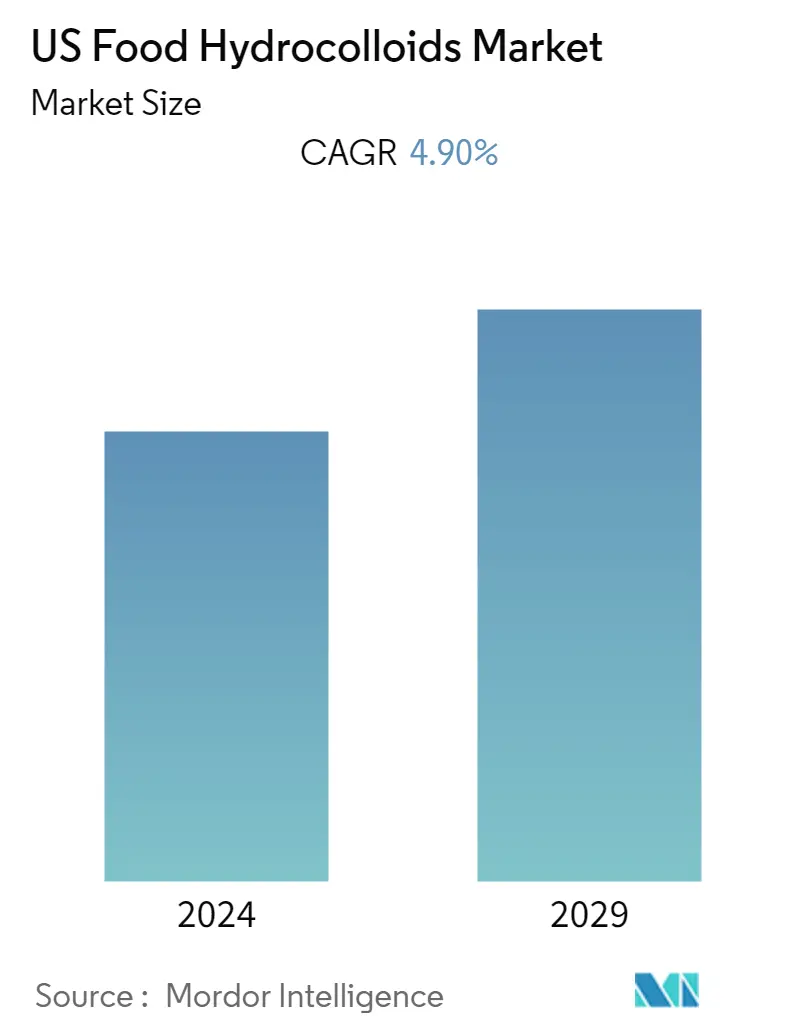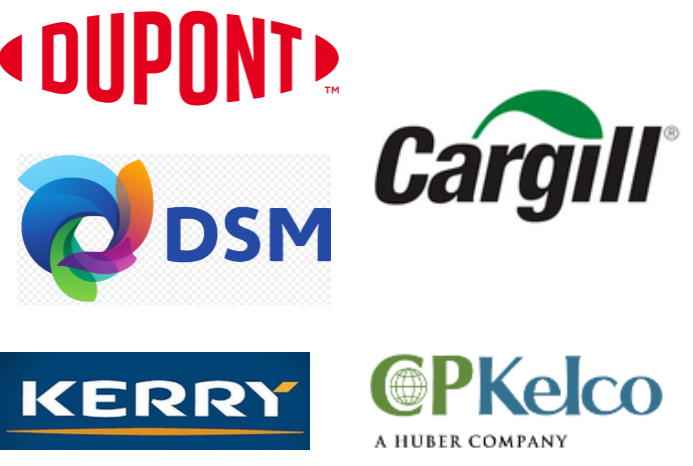Market Size of US Food Hydrocolloids Industry

| Study Period | 2019 - 2029 |
| Base Year For Estimation | 2023 |
| Forecast Data Period | 2024 - 2029 |
| Historical Data Period | 2019 - 2022 |
| CAGR | 4.90 % |
| Market Concentration | Low |
Major Players
*Disclaimer: Major Players sorted in no particular order |
US Food Hydrocolloids Market Analysis
US Food Hydrocolloids Marketis forecasted to grow at a CAGR of 4.9% during the forecast period.
- Consumer preference for natural ingredients and the varied applications of hydrocolloids in the food and beverage industry are some of the reasons for the uptick in demand.
- The changing consumer demographics in terms of lifestyle changes and growing working population resulting in consumer demand for convenience and processed foods. This is seen as an opportunity for the manufacturers to adopt hydrocolloids in their manufacturing process.
- The market is largely driven by increased Research & Development and innovations in hydrocolloids.
US Food Hydrocolloids Industry Segmentation
The scope ofUS Food Hydrocolloids Market is segmented byType (Starch, Gelatin gum, Xanthan gum, carrageenan and Others), Application (Bakery, Dairy & Frozen Desserts, Confectionery, Meat Poultry & Sea Food Products, Beverages, and Others)
| By Type | |
| Starch | |
| Gelatin gum | |
| Xanthan gum | |
| Carrageenan | |
| Others |
| By Application | |
| Bakery | |
| Dairy & Frozen Products | |
| Oils & Fats | |
| Confectionary | |
| Meat Poultry & Sea Food Products | |
| Beverages | |
| Others |
US Food Hydrocolloids Market Size Summary
The US food hydrocolloids market is experiencing a notable expansion, driven by a growing consumer preference for natural ingredients and the diverse applications of hydrocolloids within the food and beverage sector. This demand is further fueled by shifts in consumer demographics, such as lifestyle changes and an increasing working population, which have led to a heightened demand for convenience and processed foods. Manufacturers are seizing this opportunity to incorporate hydrocolloids into their production processes. The market's growth is significantly supported by advancements in research and development, alongside continuous innovations in hydrocolloid applications.
Xanthan gum, a hydrocolloid derived from bacterial fermentation, is gaining traction as a cost-effective alternative to guar gum, finding its use in various food applications like salad dressings, sauces, and dairy products. The food and beverage industry's expansion is expected to further propel market growth. In the meat, poultry, and seafood sectors, hydrocolloids are utilized as additives to enhance product quality, shelf life, and safety. The market features prominent companies such as Cargill, CP Kelco, Dupont, and Royal DSM, which are actively involved in expanding their hydrocolloid businesses through strategic acquisitions and innovations to meet the demand for sustainable and effective food solutions.
US Food Hydrocolloids Market Size - Table of Contents
-
1. MARKET DYNAMICS
-
1.1 Market Drivers
-
1.2 Market Restraints
-
1.3 Porter's Five Forces Analysis
-
1.3.1 Threat of New Entrants
-
1.3.2 Bargaining Power of Buyers/Consumers
-
1.3.3 Bargaining Power of Suppliers
-
1.3.4 Threat of Substitute Products
-
1.3.5 Intensity of Competitive Rivalry
-
-
-
2. MARKET SEGMENTATION
-
2.1 By Type
-
2.1.1 Starch
-
2.1.2 Gelatin gum
-
2.1.3 Xanthan gum
-
2.1.4 Carrageenan
-
2.1.5 Others
-
-
2.2 By Application
-
2.2.1 Bakery
-
2.2.2 Dairy & Frozen Products
-
2.2.3 Oils & Fats
-
2.2.4 Confectionary
-
2.2.5 Meat Poultry & Sea Food Products
-
2.2.6 Beverages
-
2.2.7 Others
-
-
US Food Hydrocolloids Market Size FAQs
What is the current US Food Hydrocolloids Market size?
The US Food Hydrocolloids Market is projected to register a CAGR of 4.90% during the forecast period (2024-2029)
Who are the key players in US Food Hydrocolloids Market?
Cargill, Incorporated, CP Kelco, Dupont, Kerry Group and Royal DSM N.V. are the major companies operating in the US Food Hydrocolloids Market.

